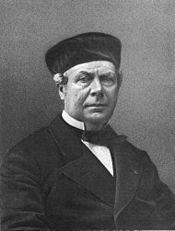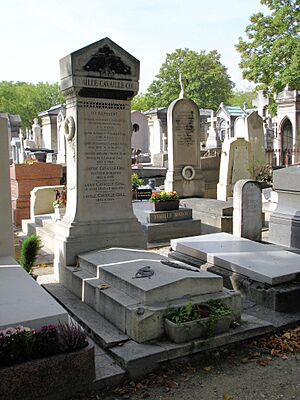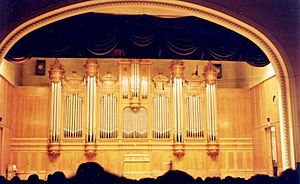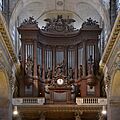Aristide Cavaillé-Coll facts for kids
Quick facts for kids
Aristide Cavaillé-Coll
|
|
|---|---|
 |
|
| Born | 4 February 1811 Montpellier, France
|
| Died | 13 October 1899 (aged 88) Paris, France
|
Aristide Cavaillé-Coll (born February 4, 1811 – died October 13, 1899) was a famous French organ builder. He is known as the best organ builder of the 19th century. He created new ways to build organs that changed how organs were made, played, and composed for, even into the early 1900s.
Aristide also wrote scientific articles about how organs are built. He shared his research and experiments. He invented the "symphonic organ". This type of organ could change its sound smoothly and quickly, just like a symphony orchestra. He achieved this by:
- Inventing new types of organ pipes, like the flûte harmonique (harmonic flute) and trompette harmonique (harmonic trumpet).
- Creating special air systems (divided windchests) with different air pressures.
- Making groups of organ sounds (called jeux d'anches and jeux de fonds) that allowed organists to change sounds quickly without taking their hands off the keyboards.
- Planning organs based on an "orchestral quartet" idea, meaning they could sound like a whole orchestra.
Some of his most famous organs are in Paris. These include the organs in Saint-Denis Basilica (1841), Église de la Madeleine, Sainte-Clotilde Basilica (1859), and Saint-Sulpice church (his biggest organ). He also built organs for Notre-Dame Cathedral and the Sacré-Cœur Basilica. After Cavaillé-Coll passed away, his business was continued by Charles Mutin.
In the 20th century, some organ builders wanted to go back to an older, more Baroque style. But today, Cavaillé-Coll's organ designs are popular again.
Contents
His Life and Work
Aristide Cavaillé-Coll was born in Montpellier, France. His family had been organ builders for generations. He showed a great talent for inventing and building things from a young age. He was an amazing artist when he designed and built his famous instruments. People say there was a "before" and "after" Cavaillé-Coll in organ building.
His organs are called "symphonic organs" because they can sound like many different instruments and combine those sounds. His largest and most impressive organ is in Saint-Sulpice, Paris. This organ has 100 different sounds (called stops) and five keyboards (called manuals). It is still mostly in its original state and might even become a UNESCO World Heritage Site.
Cavaillé-Coll was very focused on his art, but he wasn't as good with money. His amazing handcrafted organs, which were the best at the time, weren't enough to keep his company from having money problems. His business was taken over by Charles Mutin in 1898, shortly before Aristide died. Mutin continued building organs, but by the 1940s, the company almost disappeared.
Cavaillé-Coll died in Paris on October 13, 1899. He is buried in the Montparnasse Cemetery.
How He Changed Organ Building
Cavaillé-Coll made many new inventions that completely changed how organs were built, played, and how music was written for them.
- He changed the layout of the organ keyboards. He put the main keyboard, called the Grand-Orgue, at the bottom. He also added couplers, which allowed the organist to play all the sounds of the organ from this one keyboard.
- He improved the "swell box". This is a part of the organ that can make the sound louder or softer. He designed a special pedal that allowed the organist to open and close the swell shutters easily, giving the organ more ways to express emotion.
- He changed how organ pipes were made and "voiced" (adjusted to make their sound). This led to a whole new group of "harmonic" sounds, like harmonic flutes and trumpets. He also created stops that sounded like orchestral instruments, such as the bassoon, oboe, and English horn.
- He made the harmonic flute stop very popular. Along with other stops like the montre (principals), gambe (strings), and bourdon (flutes), these formed the "foundations" (fonds) of the organ's sound.
- He came up with the "orchestral quartet" idea. This meant designing organs to have four main groups of sounds: principals, flutes, strings, and reeds, just like an orchestra.
- He introduced "divided windchests". These allowed different parts of the organ to use higher air pressures. This meant that groups of reed stops (anches) could be added or removed quickly using a pedal. Higher air pressures also allowed for more 8' (normal pitch) stops in each section, so full sets of foundation and reed sounds could be layered on top of each other. Sometimes, he even made the higher notes louder than the lower notes to make melodies stand out.
The famous composer Charles-Marie Widor said that Cavaillé-Coll invented many things, like different air pressures and special pedal systems. He also said that Cavaillé-Coll made the organ mechanics so perfect that every pipe, no matter its size or sound, would play instantly when a finger touched a key. This allowed for smooth changes in loudness, clear beginnings of notes, and a wide range of beautiful sounds.
For larger organs with higher air pressures, Cavaillé-Coll used a device called the Barker lever. This made it easier to play all the keyboards together and use the full organ without too much effort. He also invented a special system for changing sounds on his five-manual organ at Église Saint-Sulpice, Paris. All these inventions allowed the organ to go from very soft (pianissimo) to very loud (fortissimo) smoothly, which was new for organs.
His organ at the Basilique Ste-Clotilde, Paris was one of the first to have many of these new features. This organ greatly influenced César Franck, a famous composer who was the organist there. Franck's organ music has inspired many organist-composers who came after him. Cavaillé-Coll kept developing his idea of the symphonic organ throughout his career, inspired by the organists of his time.
His Lasting Influence
Marcel Dupré, another famous musician, once said that writing music for an orchestra is different from writing for an organ. But he added that for Cavaillé-Coll's symphonic organs, you have to be very careful, as they are like orchestras themselves.
Almost a century before, César Franck was thrilled by a smaller Cavaillé-Coll organ in Paris. He famously exclaimed, "Mon nouvel orgue ? C'est un orchestre !" which means, "My new organ? It's an orchestra!" Franck later became the organist for a much larger Cavaillé-Coll organ at St Clotilde in Paris.
In 1878, Franck played a concert on the four-manual Cavaillé-Coll organ at the Palais du Trocadéro in Paris. This organ was later moved and rebuilt several times, and it is now in the Auditorium Maurice Ravel in Lyon. Franck's famous "Trois Pièces" (Three Pieces) were first played on the Trocadéro organ.
Film About His Work
A documentary film called The Genius of Cavaillé-Coll was released in 2012. It celebrated 200 years since Cavaillé-Coll's birth and 150 years since his organ at St Sulpice was built. The film won an award from the BBC Music Magazine in 2014.
Where You Can Find His Organs
For a full list of all organs by Cavaillé-Coll, see: List of Organs by Aristide Cavaillé-Coll
In Europe
In France
- Bergerac: Saint Jacques
- Bonsecours: Basilique Notre-Dame
- Caen: Abbey of Saint-Étienne (50 stops, 3 manuals)
- Carcassonne: Cathedral
- Castelnau-d'Estrétefonds: Saint-Martin
- Dreux: Chapelle royale
- Épernay: Saint-Pierre Saint-Paul
- Lavaur: Cathedral
- Luçon: Cathedral
- Lyon: Saint-François-de-Sales
- Orléans: Cathedral
- Mazamet: Saint-Sauveur
- Nancy: Cathedral (65 stops, 4 manuals)
- Paris: American Cathedral (72 stops, 4 manuals)
- Paris: Saint-Roch
- Paris: La Madeleine (58 stops, 3 manuals)
- Paris: Notre-Dame-de-la-Croix (26 stops, 2 manuals)
- Paris: Notre Dame
- Paris: Notre-Dame-de-l'Assomption
- Paris: Pentemont Abbey
- Paris: Saint-Antoine-des-Quinze-Vingts
- Paris: Sainte-Clotilde Basilica (71 stops, 3 manuals)
- Paris: Saint-Sulpice (102 stops, 5 manuals)
- Paris: Saint-Vincent-de-Paul (66 stops, 3 manuals)
- Paris: Sainte-Trinité (61 stops, 3 manuals)
- Paris: Saint-Jean-de-Montmartre (28 stops, 2 manuals)
- Paris: Sacré-Cœur (78 stops, 4 manuals)
- Paris: Val-de-Grâce
- Courbevoie (near Paris): Saint-Maurice de Bécon
- Perpignan: Cathedral
- Rabastens: Notre-Dame-du-Bourg Church (smallest, with only 20 stops)
- Rouen: Church of St. Ouen. (64 stops, 4 manuals)
- Saint-Denis: Basilica (47 stops, 4 manuals)
- Saint-Germain-en-Laye: Saint-Germain church
- Saint-Omer: Cathedral (49 stops, 4 manuals)
- Saint-Yrieix-la-Perche: Collégiale du Moustier
- Toulouse: Saint-Sernin Basilica (51 stops, 3 manuals)
- Trouville-sur-Mer: Notre-Dame des Victoires
- Vimoutiers: Notre-Dame
- Yport: Eglise saint-Martin
In Spain
- Alegia: San Juan
- Azkoitia: Santa María
- Azpeitia: Basílica de Loyola
- Bilbao: Santa María de Begoña
- Getaria (Guetaria): San Salvador
- Irún: Santa María
- Lekeitio: Basílica de la Asunción de Nuestra Señora (Lekeitio)
- Madrid: Basílica de San Francisco el Grande
- Mutriku (Motrico): Santa Catalina
- Oiartzun: San Esteban
- Pasaia (Pasajes)
- San Sebastián (Donostia): Résidence de Zorroaga
- San Sebastián (Donostia): San Marcial d’Altza
- San Sebastián (Donostia): Santa María del Coro
- San Sebastián (Donostia): Santa Teresa
- San Sebastián (Donostia): San Vicente
- Urnieta: San Miguel
- Vidania (Bidegoyan), San Bartolomé
In the United Kingdom
- Channel Islands, Jersey: Highlands College
- Cheshire, Warrington: Parr Hall
- Hampshire, Farnborough: St Michael's Abbey
- Hampshire, Isle of Wight: Quarr Abbey
- Manchester: The Town Hall
- Renfrewshire, Paisley: Paisley Abbey
In the Netherlands
In Belgium
- Brussels: Royal Conservatory of Music
- Gesves : Saint Maximin (50 stops, 4 manuals)
- Ghent: Saint Nicholas' Church, Ghent
- Hasselt: Sacred Heart Church
- Leuven: Jesuit Church Heverlee
- Leuven: Saint Joseph's Church
In Portugal
- Lisbon, Portugal: Igreja de São Luís dos Franceses
- Lisbon, Portugal: Igreja de São Mamede
In Italy
- Rome, Italy: Chapel of the Casa Santa Maria of the Pontifical North American College
Cavaillé-Coll also designed a very large organ for Saint Peter's Basilica in Rome, but it was never built. A small model of it is still kept there.
In Denmark
- Copenhagen, Denmark: Jesus Church (1890)
In Russia
- Moscow, Russia: Bolshoi Hall of Moscow Conservatory, Russia (installed by Charles Mutin)
In Latin America
In Venezuela
- Caracas: Iglesia de la Parroquia San Francisco. Still used regularly.
- Caracas: Iglesia de la Parroquia Altagracia (Not working)
- Caracas: Iglesia de la Parroquia Santa Teresa. Still used regularly.
- Caracas: Iglesia de la Parroquia San José (In a delicate state)
- Caracas: Parroquia La Encarnación del Valle. After many years of silence, it has been played regularly since 2011.
- Los Teques: Catedral (Not working)
In Brazil
- Belém: Catedral da Sé (1882)
- Campinas: Catedral Metropolitana (1883)
- Campo Largo: Igreja Matriz de Nossa Senhora da Piedade (1892)
- Itu: Igreja Matriz Nossa Senhora da Candelária (1882)
- Jundiaí: Catedral de Nossa Senhora do Desterro (1895)
- Lorena: Catedral Nossa Senhora da Piedade (1889)
- Rio de Janeiro: Igreja Nossa Senhora do Carmo da Lapa (1898)
- Rio de Janeiro: Capela do Colégio Sion do Cosme Velhos (Mutin)
- Rio de Janeiro: Igreja de Nossa Senhora de Bonsucesso (Mutin)
- Rio de Janeiro: Capela da Santa Casa (1882)
- Salvador: Igreja da Ordem Terceira do Carmo (1888)
- São Paulo: Igreja de São José do Ipiranga (1863)
- São Paulo: Igreja do Senhor Bom Jesus do Brás (1875)
In Mexico
- Mazatlán, Mexico: Catedral Basílica de la Inmaculada Concepción
In Chile
- Valparaíso, Chile: Iglesia de los Sagrados Corazones (French Fathers Church) (1872)
In Argentina
Most of the organs listed here were sold and installed by Mutin-Cavaillé Coll. This company took over Cavaillé-Coll's business after he died in 1899. Argentina bought many pipe organs in the early 1900s. The company even opened two shops in Buenos Aires.
- Lujan, Basilica de Lujan
- Basílica del Santísimo Sacramento (1912)
- Capilla del Colegio "La Salle" (1926)
- Iglesia de San Juan Bautista (around 1920)
- Basílica del Sagrado Corazón de Jesús (around 1906)
- Basílica de San Nicolás de Bari (main organ)
- Basílica de San Nicolás de Bari (crypt organ)
- Capilla de la "Casa de la empleada"
- Parroquia de "Nuestra Señora del Valle"
- Parroquia de "San Martín de Tours" (around 1910)
- Parroquia de "San Cristobal"
- Catedral de San Isidro (1906)
- Parroquia de "Nuestra Señora de Aránzazu" (San Fernando) (1907)
- Parroquia de "San Francisco Solano" (Bella Vista) (1906)
In Costa Rica
- Parroquia Inmaculada Concepción (Heredia) (around 1904)
- Parroquia Nuestra Señora de la Soledad (San José) (around 1906)
In Asia
- Fuji, Japan: Haus Sonnenschein
- Beijing, China: Beitang (used regularly until at least 1938)
Asteroid
An asteroid was named after Cavaillé-Coll: 5184 Cavaillé-Coll.
Images for kids
See also
 In Spanish: Aristide Cavaillé-Coll para niños
In Spanish: Aristide Cavaillé-Coll para niños













